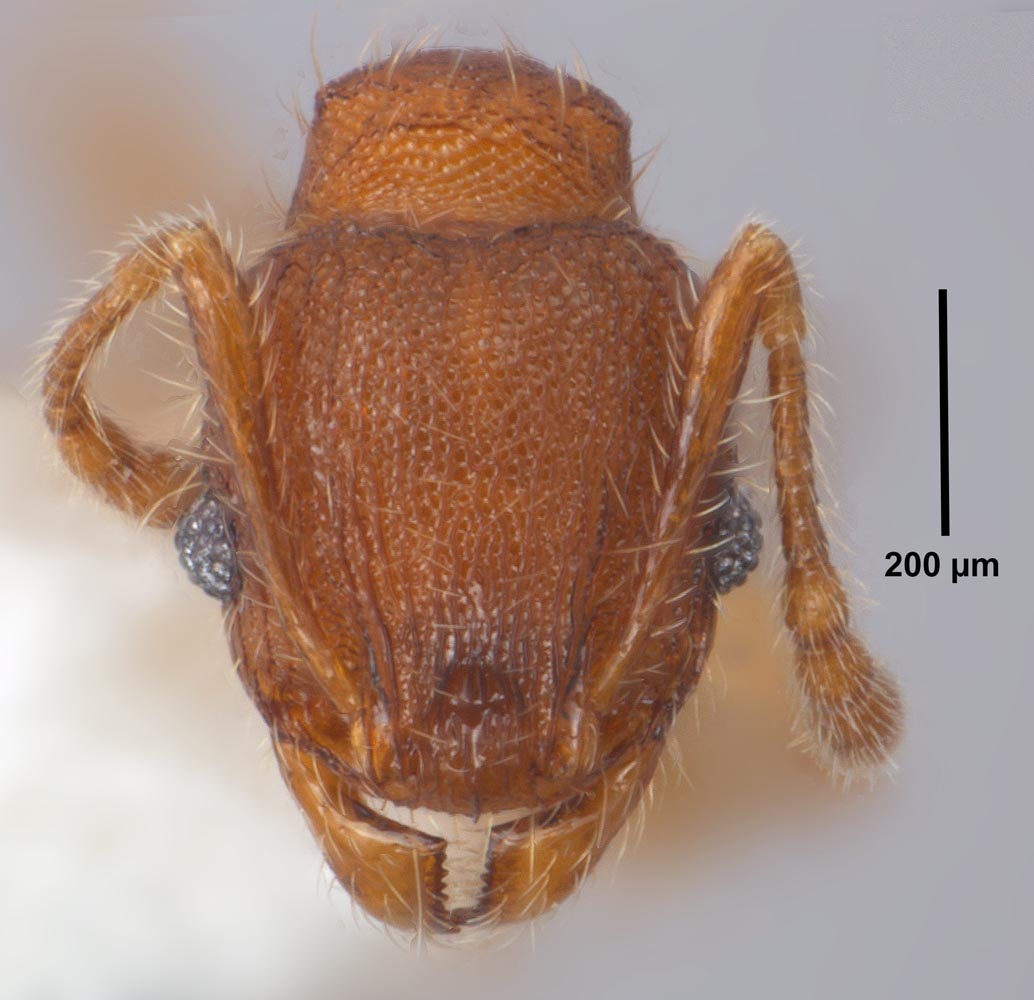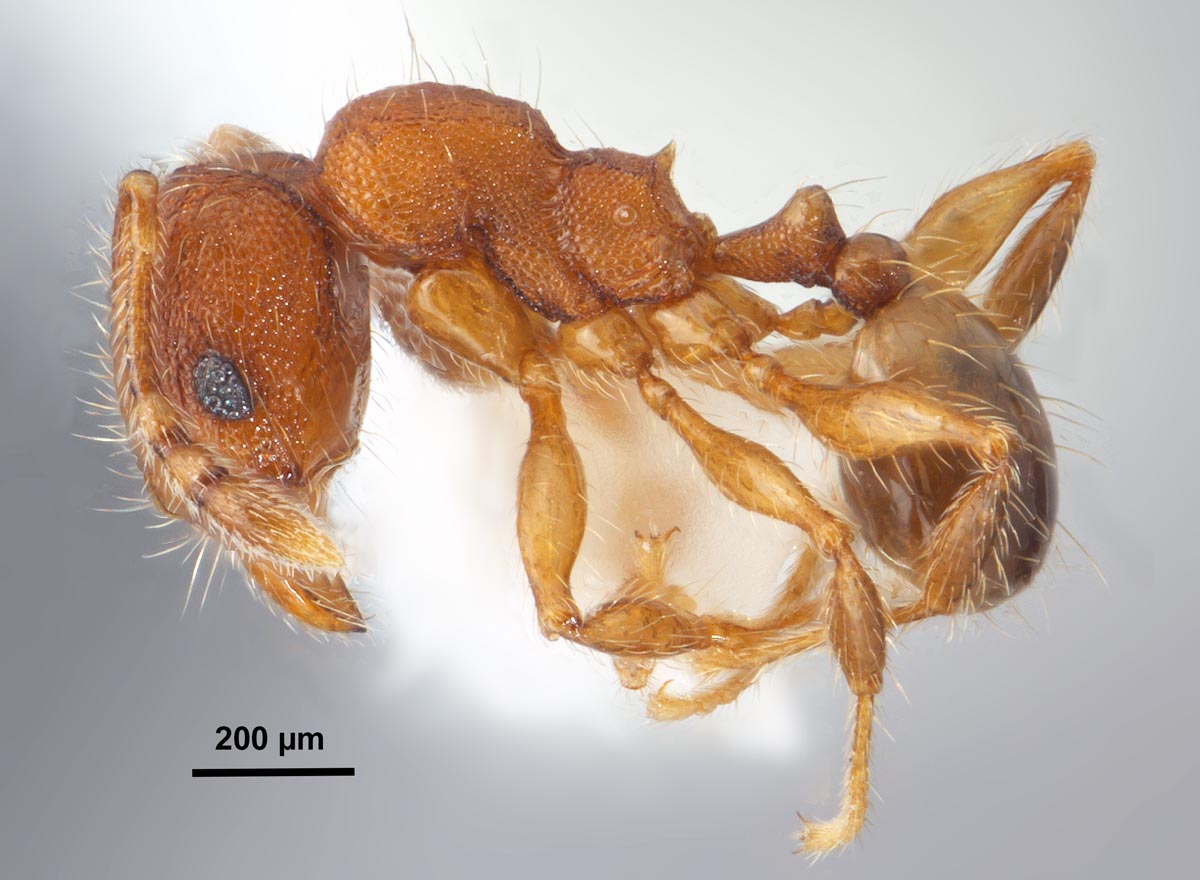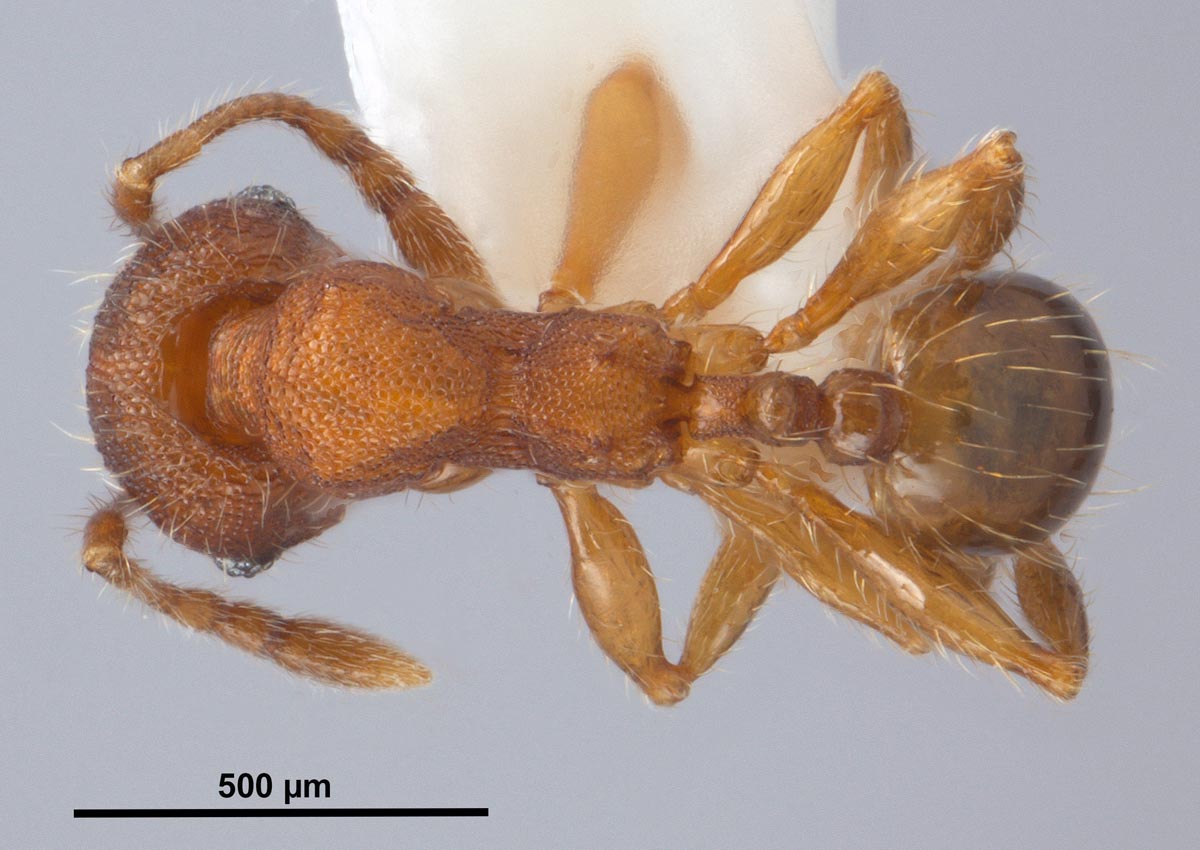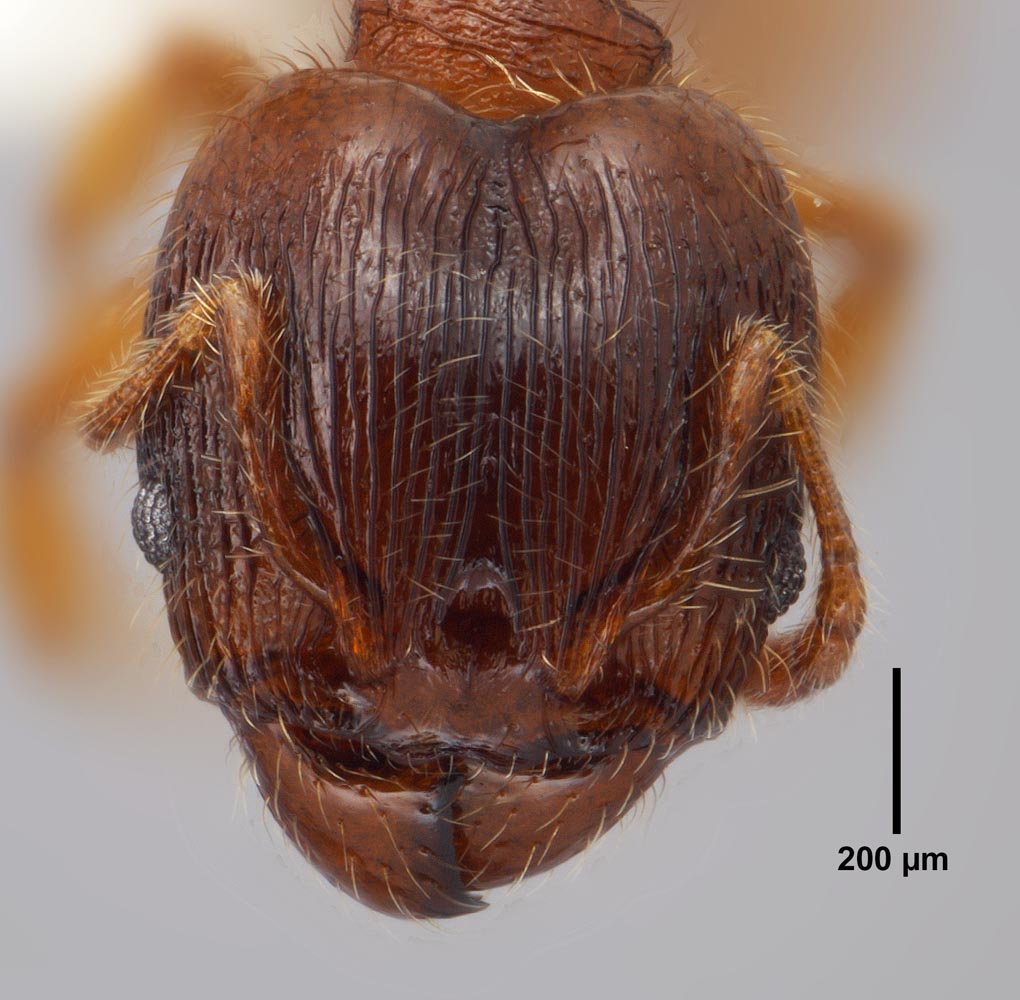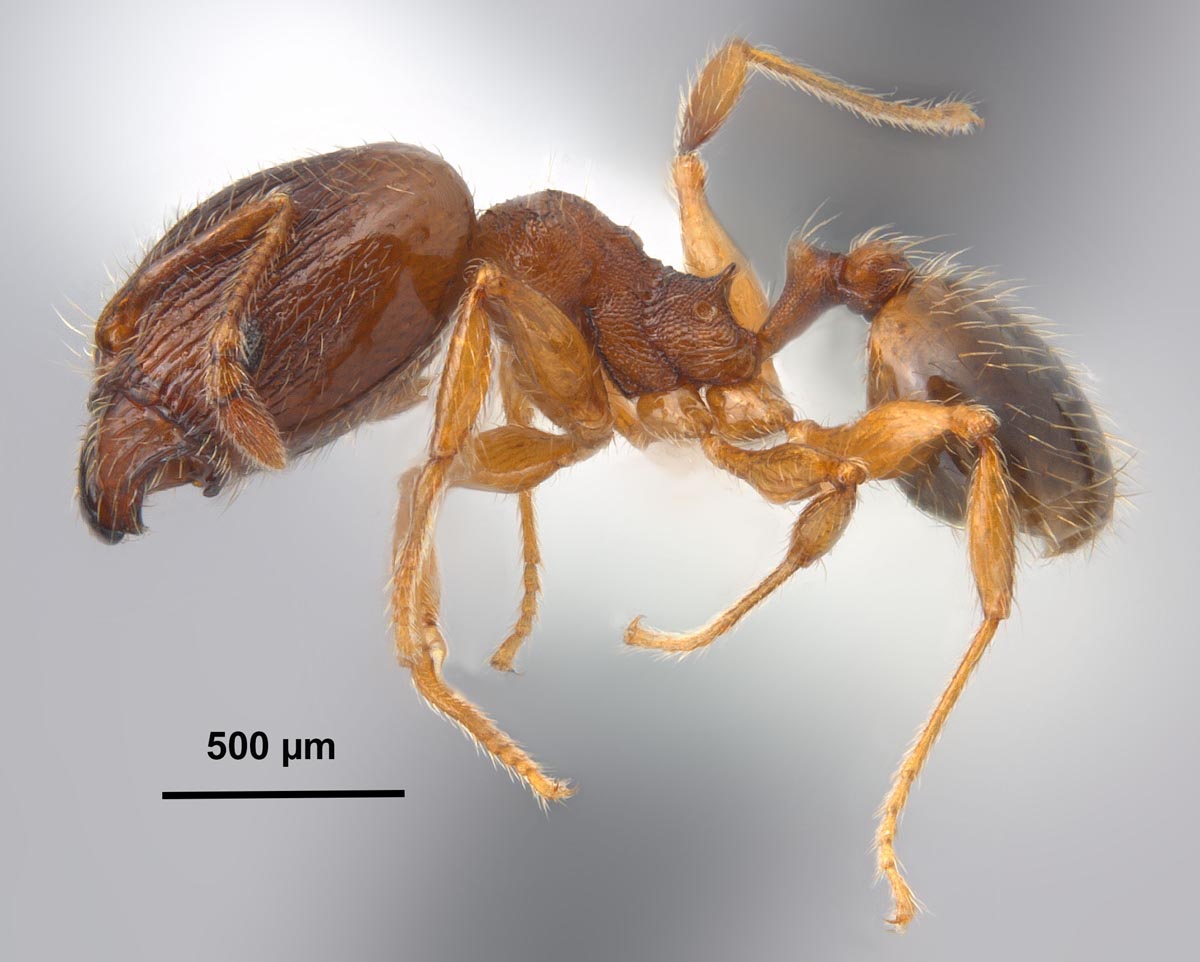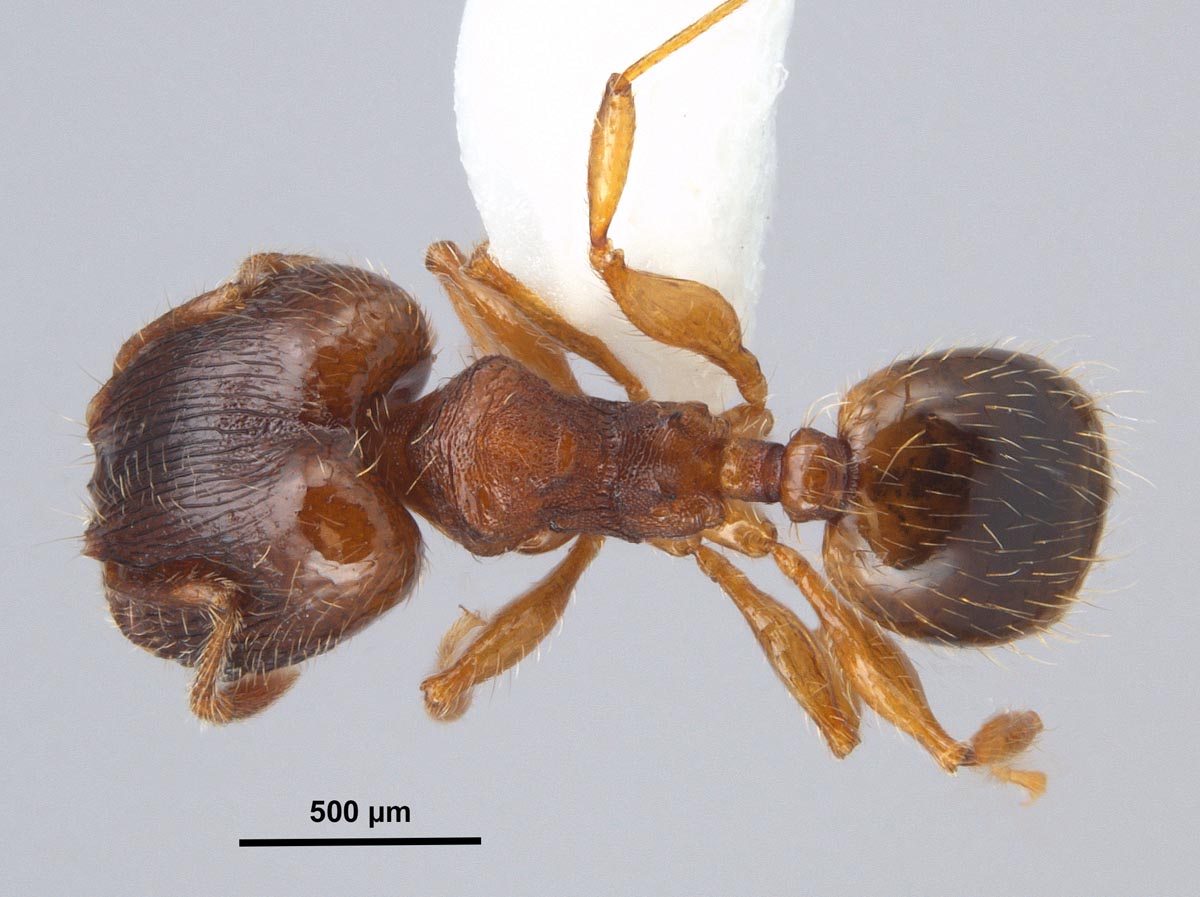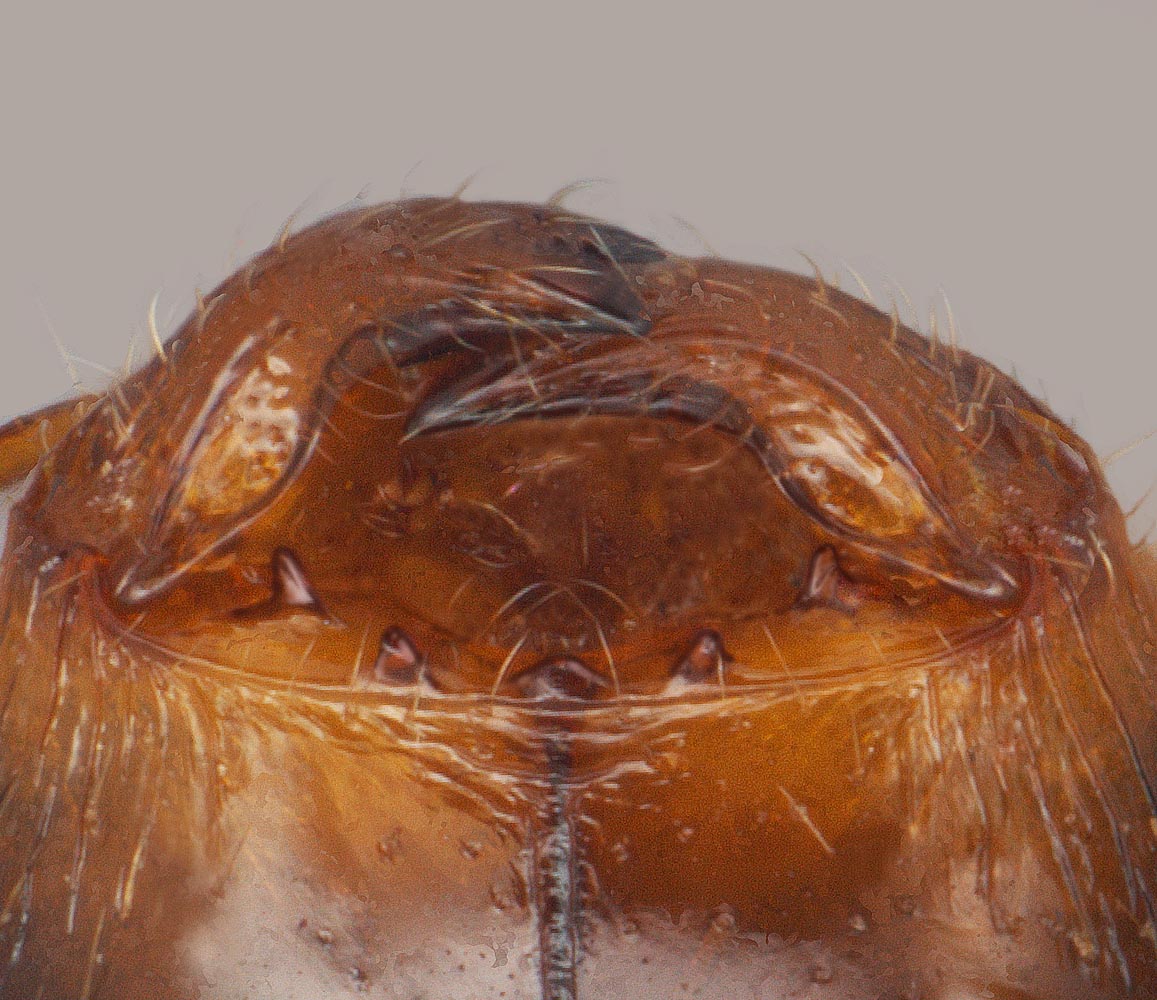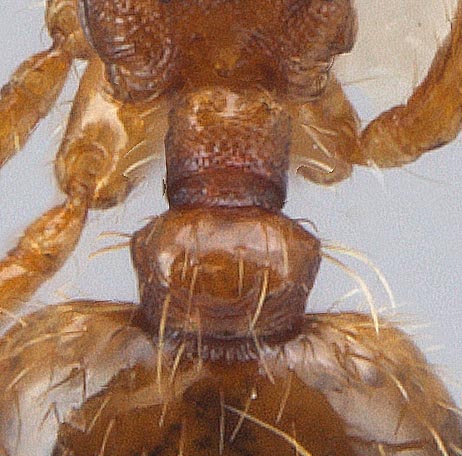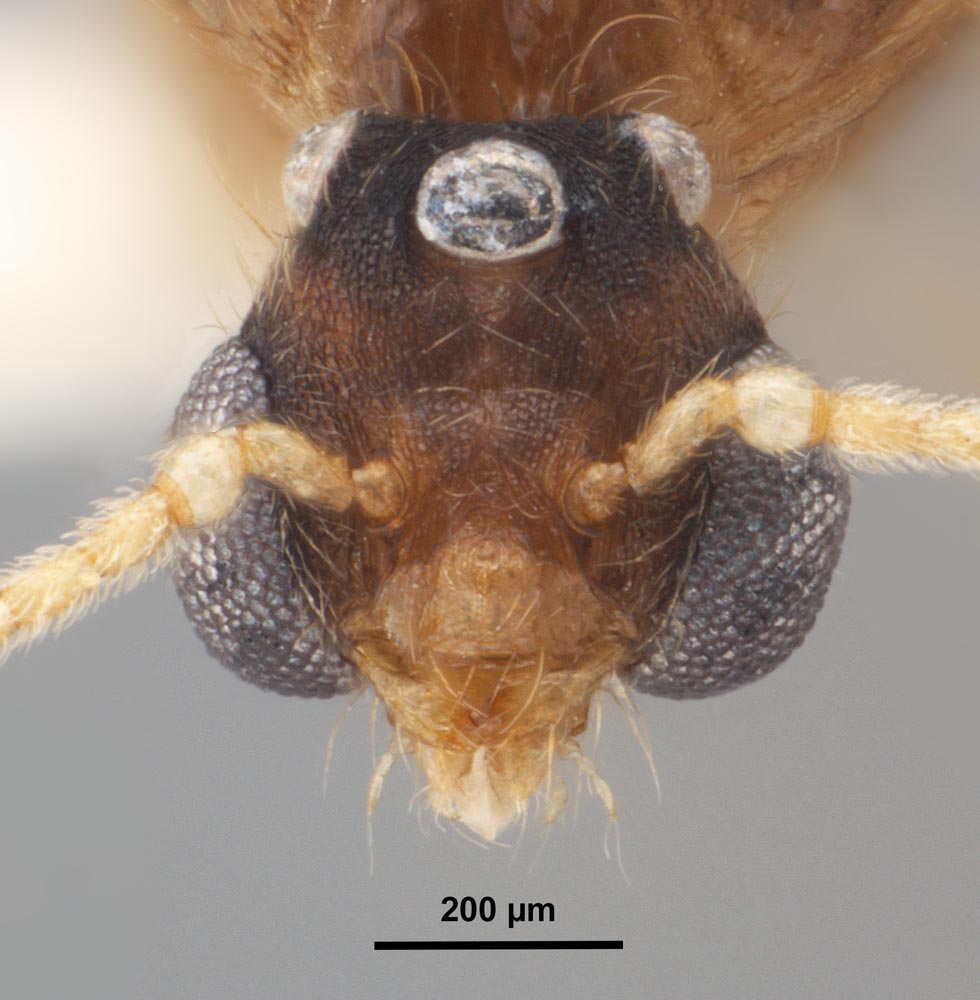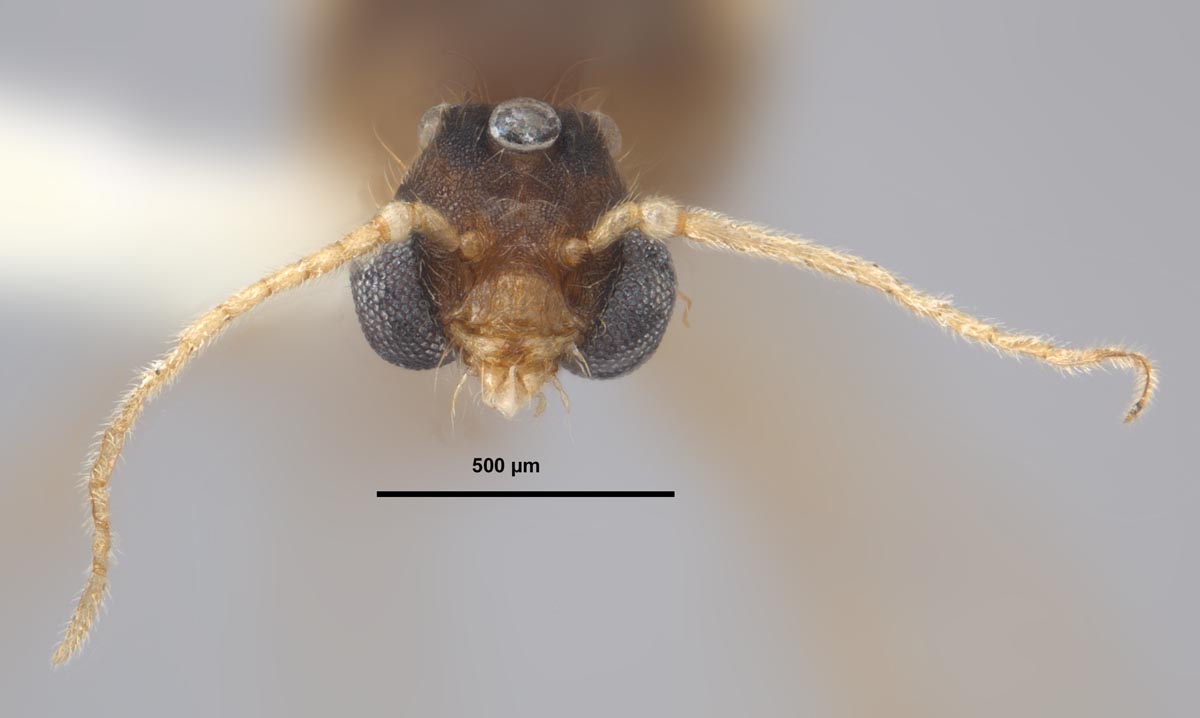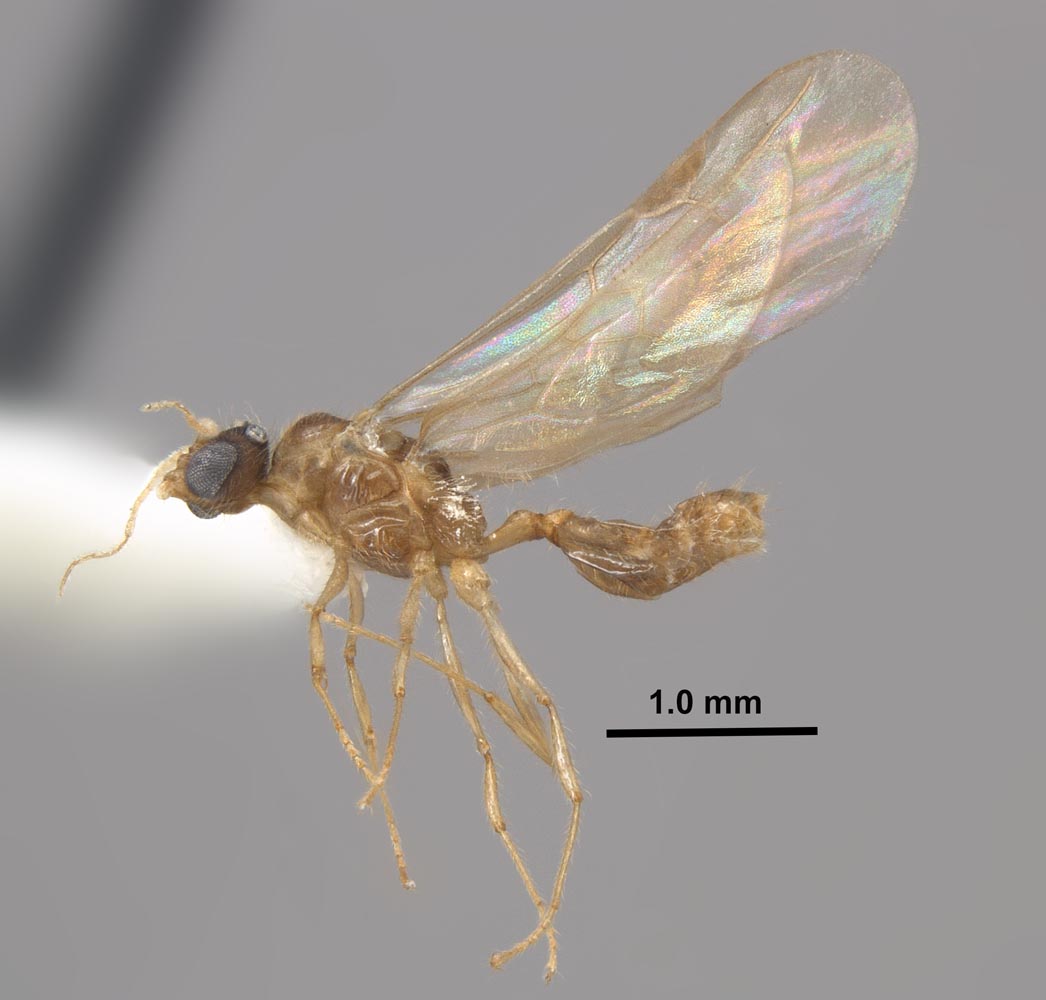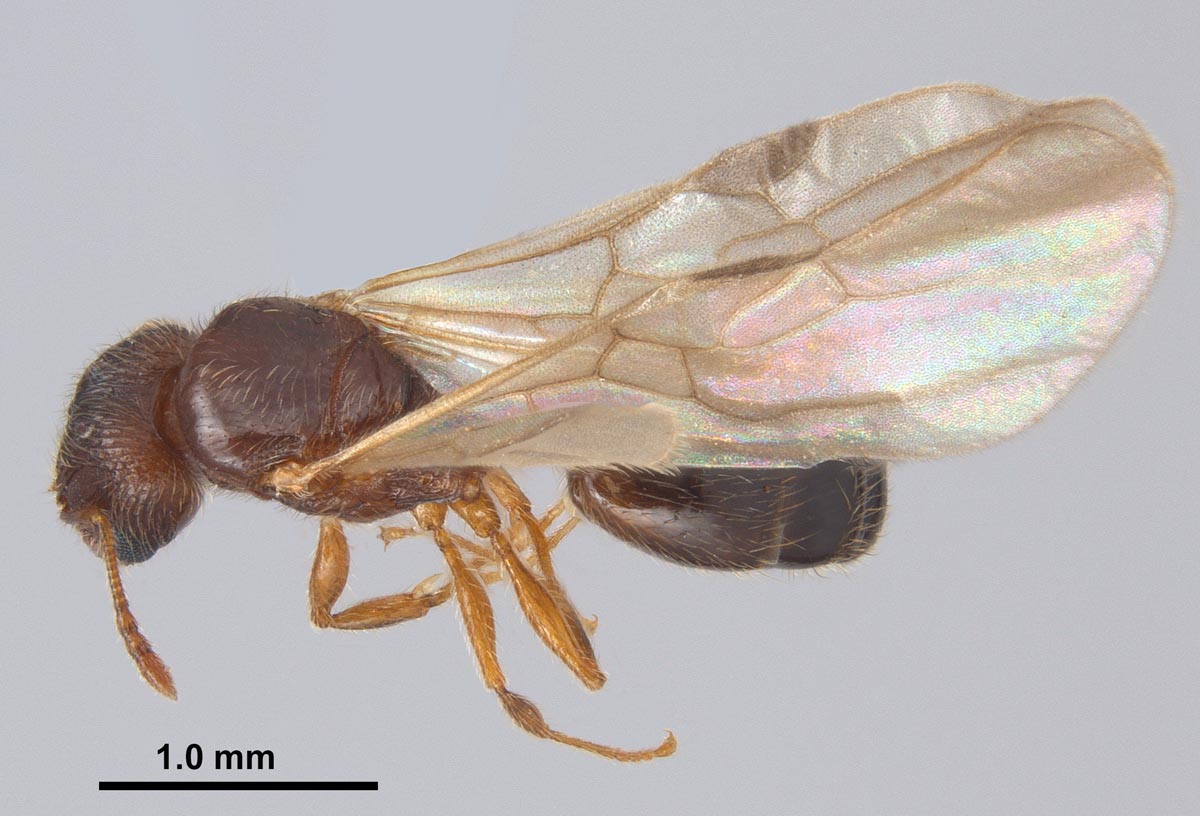Subfamily MYRMICINAE Navigating big-headed ant
|
||
Pheidole navigans, full face view of a major worker (Hancock Co., MS) (photo by Joe A. MacGown & James Lewis) |
Pheidole navigans, lateral view of a minor worker (Hancock Co., MS) (photo by Joe A. MacGown & James Lewis) |
Pheidole navigans, dorsal view of a minor worker (Hancock Co., MS) (photo by Joe A. MacGown & James Lewis) |
Pheidole navigans, full face view of a major worker (Lauderdale Co., MS) (photo by Joe A. MacGown & James Lewis) |
Pheidole navigans, lateral view of a major worker (Lauderdale Co., MS) (photo by Joe A. MacGown & James Lewis) |
Pheidole navigans, lateral view of a major worker (Lauderdale Co., MS) (photo by Joe A. MacGown & James Lewis) |
Pheidole navigans, hypostomal teeth of a major worker (Lauderdale Co., MS) (photo by Joe A. MacGown ) |
Pheidole navigans, dorsal view of petiole and postpetiole of a major worker (Lauderdale Co., MS) (photo by Joe A. MacGown ) |
Pheidole navigans, full face view of a male (Hinds Co., MS) (photo by Joe A. MacGown & James Lewis) |
Pheidole navigans, full face view of a male (Hinds Co., MS) (photo by Joe A. MacGown & James Lewis) |
Pheidole navigans, lateral view of a male (Hinds Co., MS) (photo by Joe A. MacGown & James Lewis) |
Pheidole navigans, dorsal view of a male (Hinds Co., MS) (Hinds by Joe A. MacGown & James Lewis) |
 |
||
| Pheidole navigans, full face view of a dealate queen (Forrest Co., MS) (photo by Joe A. MacGown & James Lewis) | Pheidole navigans, lateral view of a dealate queen (Forrest Co., MS) (photo by Joe A. MacGown & James Lewis) |
Pheidole navigans, lateral view of a dealate queen (Forrest Co., MS) (photo by Joe A. MacGown & James Lewis) |
Introduction Pheidole navigans (Forel) (Myrmicinae), the navigating big-headed ant, is a small, reddish brown species thought to be native to the Neotropics (Sarnat et al. 2015). This species has become widespread and abundant along the Coastal Plain from southeastern Texas to eastern South Carolina. In Mississippi, this species is now well established in southern third of the state. Until a recent paper on invasive Pheidole species of the world was published by Sarnat et al. in 2015, specimens of this species from the United States and the Caribbean were identified as P. moerens Wheeler. However, after examination of type specimens, Sarnat et al. (2015) removed P. navigans from synonomy with P. flavens, and after examining southeastern US specimens, they proposed that US and Caribbean specimens previously identified as P. moerens were actually P. navigans. Taxonomic History (Bolton 2016) Diagnosis Identification Major Worker: Small, larger than minor worker (HW 0.80–0.84 mm, HL 0.86–0.91 mm, SL 0.44–0.46mm, EL 0.11–0.13mm, MeSL 0.52–0.55mm, SPL 0.05–0.06 mm, PetW 0.08–0.09 mm, PpW 0.11–0.13 mm, PronW 0.28–0.31 mm) (MEM specimens) (n = 5). Head, mesosoma, waist, and antennae dark reddish brown; gaster darker brown to somewhat infuscated at base to darker brownish black posteriorly; legs lighter, orangish brown. Head greatly enlarged, larger than mesosoma, almost as wide as long; posterior margin of head deeply concave, corners of head strongly rounded; posterior corners of head shiny, lacking sculpture, remainder of head with strong longitudinal rugae and some rugureticulation between eye and frontal carina, spaces between mostly shiny; clypeus and mandibles mostly lacking sculpture; frontal triangle prominent, shiny; entire head with scattered, but regular short, erect setae, mostly directly anteriorly and away from head on and near margins, but setae located on central portion of head directed toward midline; eyes small, located below midline of head; ocelli lacking; antennae 12-segmented, with 3-segmented club; scapes short, about half of head length; mandible triangular, enlarged, edentate except for apical tooth; venrally, five hypostomal teeth present, mid tooth wide and short, inner and outer teeth stout triangular;. Mesosoma sides and dorsum of foveolate, transverse carina present on dorsum of pronotum, a few weak carina present on mesopleura and sides of propodeum; scattered erect setae present on promesonotal dorsum; with distinct promesonotal groove present; strong metanotal groove present; propodeum set distinctly below level of promesonotum; propodeal declivity concave, propodeal spines strong, somewhat finger-like, directed upward and slightly posteriorly; propodeal spiracle circular. Waist two-segmented, with scattered elongate, flexuous setae present on both waist segments: petiole about twice as long as wide (dorsal view), pedunculate, node raised, and conical in lateral view, somewhat rectangular in dorsal view; sides of petiole foveolate, dorsum shiny; postpetiole wider than long in dorsal view, node elliptical, some foveolate sculpture present posterolaterally, remainder shiny. Gaster smooth and shiny, lacking obvious sculpture; with scattered elongate, flexuous setae that are directed posteriorly present; sting absent. Queen: Small, larger then major worker (HW 0.81–0.90 mm, HL 0.74–0.83 mm, SL 0.45–0.49 mm, EL 0.24–0.27 mm, MeSL 1.16–1.22 mm, SPL 0.08–0.11 mm, PetW 0.23–0.25 mm, PpW 0.37–0.40 mm, PronW 0.71–0.75 mm, FWL 3.80–4.20 mm) (MEM specimens) (n = 5). Head (including mandibles and antennae), mesosoma, and waist dark reddish brown; gaster dark brownish black; legs orangish brown; and wings hyaline with dark stigma. Head slightly wider than long, widest posteriorly before gradually diverging anteriorly, posterior margin broadly concave; entire head in full face and lateral view with strong longitudinal rugae present, with transverse rugae on posterior region of head and between eye and frontal carina forming a rugoreticulate pattern, spaces between rugae shiny in mid region of head (full face view) and foveolate laterally from the approximately the edge of the frontal carina to margins of the head; entire head with numerous scattered erect setae with setae on sides of head directed posteriorly away from the head and setae on central region of head directed toward midline of head; scapes with numerous erect setae; eyes large, length of eye less than the distance between eye and posterior edge of head; ocelli conspicuous; frontal triangle obvious, with rugae from head extending through it; antennae 12-segmented, with 3-segmented club; scapes short, length about 2/3 the head length; mandible large, triangulare edentate except apical tooth. Mesosoma rounded recangular, dorsally flattened; overal shiny, mostly lacking sculpture dorsally, pronotum and propodeum with rugulate sculpture, mesopleura mostly lacking sculpture, smooth; entire mesosoma with numerous short, semi erect curved setae that are directed posteriorly. Wings translucent with light brown tint and light brown venation; forewing venation of typical myrmicine type with pterostigma and closed costal, basal, subbasal, discal, marginal, and two submarginal cells closed; hindwing lacking jugal lobe and with costal, basal, and subbasal cells. Waist two segmented, with scattered elongate, flexuous setae present on both segments: petiole about twice as long as wide (dorsal view), pedunculate, in lateral view node raised and conical, somewhat rectangular in dorsal view, sides of petiole foveolate, dorsum shiny; postpetiole wider than long in dorsal view, almost twice as long as petiole, node elliptical (dorsal view), some foveolate sculpture present posterolaterally, remainder shiny. Gaster smooth and shiny, lacking obvious sculpture; with scattered elongate, flexuous setae that are directed posteriorly present; lacking sting. Male: Small (HW 0.59–0.60 mm, HL 0.47–0.50 mm, SL 0.12 mm, EL 0.29–0.32 mm, MeSL 1.12–1.16 mm, PetW 0.15–0.16 mm, PpW 0.20–0.23 mm, PronW 0.65–0.68 mm, FWL 2.80–3.04 mm) (MEM specimens) (n = 3). Head dark brown; mesosoma, waist and gaster light brown; antennae and legs pale yellow brown; and wings hyaline. Head longer than wide, full face view head widest posteriorly measuring from outer edge of eye to eye, somewhat hexagonal in shape (excluding eyes); clypeal area with some longitudinal carinae, remainder of head with strong, tightly woven rugoreticulation; numerous erect setae of varying lengths present on head; scapes with short, semi erect setae, funiculus dense pubescent; mesosoma, waist, and gaster mostly shiny, lacking sculpture, with numerous short, semi erect setae present; eyes huge, more than half the length of head, placed on lower half of head; ocelli large and protruding; antennae 13-segmented, beaded, scapes short and rectangular, pedicel globular. Mesosoma rounded rectangular; shiny with limited sculpture; with numerous, short, erect setae; pronotum somewhat trapzoidal; mesoscutum broadly rounded anteriorly and overhanging pronotum; mesoscutellum with a declivious face that is distinctly elevated above propodeum; propodeal declivity irregular. Wings pale translucent hyaline with veins light brown; forewing venation of typical myrmicine type with pterostigma and costal, basal, subbasal, discal, and two submarginal cells closed; hindwing lacking jugal lobe and with costal, basal, and subbasal cells closed. Waist two-segmented, with limited sculputure, numerous erect setae present: petiole pedunculate, elongate, node barely raised; postpetiole short, rounded, somewhat circular. Gaster shiny, with numerous erect setate present. Biology Pest Status It seems likely that dense populations of this species have some effect on native insects that serve as prey, but the diet of P. navigans has not been investigated in detail. Deyrup, et al. (2000) reported that this species occurs throughout Florida in a wide variety of habitats, and that it may have already partially replaced P. dentigula and P. bilimeki (=floridana auct.). Because colonies are often in rotten wood, in leaf litter, and in hollow twigs and nuts on the ground or occasionally arboreal, so P. navigans may compete for nest sites with native species in the genera Aphaenogaster, Camponotus, Nylanderia, Solenopsis, Hypoponera, Strumigenys, Brachymyrmex, and other species Distribution Oceania: Hawaii (AntWeb.org, Sarnat et al. 2015). U.S. Distribution: AL, CA, FL, GA, HI, LA, MS, NC, SC, TX, WA (AntWeb.org and MEM). Acknowledgments Literature Cited Bolton, B. 2016. Bolton World Catalog Ants. Available online: http://www.antweb.org/world.jsp. Accessed 9 February 2016. Forel, A. 1901. Formiciden des Naturhistorischen Museums zu Hamburg. Neue Calyptomyrmex-, Dacryon-, Podomyrma- und Echinopla-Arten. Mitteilungen aus dem Naturhistorischen Museum in Hamburg 18:43-82. Naves, M. A. 1985. A monograph of the genus Pheidole in Florida, USA (Hymenoptera: Formicidae). Insecta Mundi 1:53-90. Sarnat, E.M.; Fischer, G.; Guénard, B.; Economo, E.P. 2015. Introduced Pheidole of the world: taxonomy, biology and distribution. ZooKeys 533:1-109. Wheeler, W. M. 1908. The ants of Porto Rico and the Virgin Islands. Bulletin of the American Museum of Natural History 24:117-158. Wilson, E. O. 2003. Pheidole in the New World. A dominant, hyperdiverse ant genus. Cambridge, Mass.: Harvard University Press, [ix] + 794 pp. Links |
||


